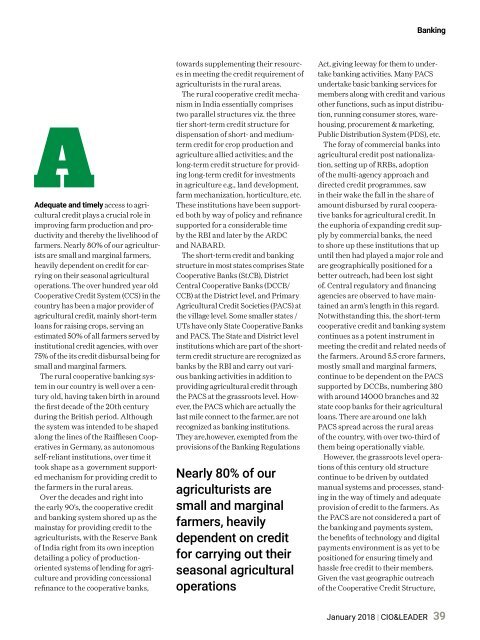CIO & LEADER-Issue-10-January 2018 (1)
The cover story on CIO&Leader's January issue is a dive into the skills that CIOs are going to develop and hire in 2018
The cover story on CIO&Leader's January issue is a dive into the skills that CIOs are going to develop and hire in 2018
You also want an ePaper? Increase the reach of your titles
YUMPU automatically turns print PDFs into web optimized ePapers that Google loves.
Banking<br />
AAdequate and timely access to agricultural<br />
credit plays a crucial role in<br />
improving farm production and productivity<br />
and thereby the livelihood of<br />
farmers. Nearly 80% of our agriculturists<br />
are small and marginal farmers,<br />
heavily dependent on credit for carrying<br />
on their seasonal agricultural<br />
operations. The over hundred year old<br />
Cooperative Credit System (CCS) in the<br />
country has been a major provider of<br />
agricultural credit, mainly short-term<br />
loans for raising crops, serving an<br />
estimated 50% of all farmers served by<br />
institutional credit agencies, with over<br />
75% of the its credit disbursal being for<br />
small and marginal farmers.<br />
The rural cooperative banking system<br />
in our country is well over a century<br />
old, having taken birth in around<br />
the first decade of the 20th century<br />
during the British period. Although<br />
the system was intended to be shaped<br />
along the lines of the Raiffiesen Cooperatives<br />
in Germany, as autonomous<br />
self-reliant institutions, over time it<br />
took shape as a government supported<br />
mechanism for providing credit to<br />
the farmers in the rural areas.<br />
Over the decades and right into<br />
the early 90’s, the cooperative credit<br />
and banking system shored up as the<br />
mainstay for providing credit to the<br />
agriculturists, with the Reserve Bank<br />
of India right from its own inception<br />
detailing a policy of productionoriented<br />
systems of lending for agriculture<br />
and providing concessional<br />
refinance to the cooperative banks,<br />
towards supplementing their resources<br />
in meeting the credit requirement of<br />
agriculturists in the rural areas.<br />
The rural cooperative credit mechanism<br />
in India essentially comprises<br />
two parallel structures viz. the three<br />
tier short-term credit structure for<br />
dispensation of short- and mediumterm<br />
credit for crop production and<br />
agriculture allied activities; and the<br />
long-term credit structure for providing<br />
long-term credit for investments<br />
in agriculture e.g., land development,<br />
farm mechanization, horticulture, etc.<br />
These institutions have been supported<br />
both by way of policy and refinance<br />
supported for a considerable time<br />
by the RBI and later by the ARDC<br />
and NABARD.<br />
The short-term credit and banking<br />
structure in most states comprises State<br />
Cooperative Banks (St.CB), District<br />
Central Cooperative Banks (DCCB/<br />
CCB) at the District level, and Primary<br />
Agricultural Credit Societies (PACS) at<br />
the village level. Some smaller states /<br />
UTs have only State Cooperative Banks<br />
and PACS. The State and District level<br />
institutions which are part of the shortterm<br />
credit structure are recognized as<br />
banks by the RBI and carry out various<br />
banking activities in addition to<br />
providing agricultural credit through<br />
the PACS at the grassroots level. However,<br />
the PACS which are actually the<br />
last mile connect to the farmer, are not<br />
recognized as banking institutions.<br />
They are,however, exempted from the<br />
provisions of the Banking Regulations<br />
Nearly 80% of our<br />
agriculturists are<br />
small and marginal<br />
farmers, heavily<br />
dependent on credit<br />
for carrying out their<br />
seasonal agricultural<br />
operations<br />
Act, giving leeway for them to undertake<br />
banking activities. Many PACS<br />
undertake basic banking services for<br />
members along with credit and various<br />
other functions, such as input distribution,<br />
running consumer stores, warehousing,<br />
procurement & marketing,<br />
Public Distribution System (PDS), etc.<br />
The foray of commercial banks into<br />
agricultural credit post nationalization,<br />
setting up of RRBs, adoption<br />
of the multi-agency approach and<br />
directed credit programmes, saw<br />
in their wake the fall in the share of<br />
amount disbursed by rural cooperative<br />
banks for agricultural credit. In<br />
the euphoria of expanding credit supply<br />
by commercial banks, the need<br />
to shore up these institutions that up<br />
until then had played a major role and<br />
are geographically positioned for a<br />
better outreach, had been lost sight<br />
of. Central regulatory and financing<br />
agencies are observed to have maintained<br />
an arm’s length in this regard.<br />
Notwithstanding this, the short-term<br />
cooperative credit and banking system<br />
continues as a potent instrument in<br />
meeting the credit and related needs of<br />
the farmers. Around 5.5 crore farmers,<br />
mostly small and marginal farmers,<br />
continue to be dependent on the PACS<br />
supported by DCCBs, numbering 380<br />
with around 14000 branches and 32<br />
state coop banks for their agricultural<br />
loans. There are around one lakh<br />
PACS spread across the rural areas<br />
of the country, with over two-third of<br />
them being operationally viable.<br />
However, the grassroots level operations<br />
of this century old structure<br />
continue to be driven by outdated<br />
manual systems and processes, standing<br />
in the way of timely and adequate<br />
provision of credit to the farmers. As<br />
the PACS are not considered a part of<br />
the banking and payments system,<br />
the benefits of technology and digital<br />
payments environment is as yet to be<br />
positioned for ensuring timely and<br />
hassle free credit to their members.<br />
Given the vast geographic outreach<br />
of the Cooperative Credit Structure,<br />
<strong>January</strong> <strong>2018</strong> | <strong>CIO</strong>&<strong>LEADER</strong><br />
39














